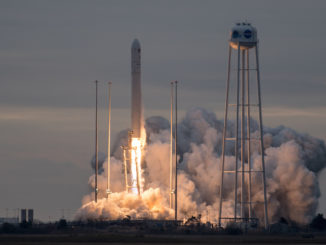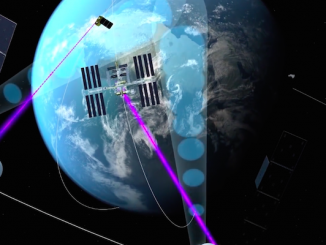
A Rocket Lab Electron launcher malfunctioned about two-and-a-half minutes after liftoff from New Zealand Saturday, destroying two BlackSky Earth-imaging satellites in the launch company’s second failed flight in less than a year.
Rocket Lab, a small satellite launch company headquartered in Long Beach, California, confirmed the failure after a live video stream from the Electron launcher appeared to show the rocket’s second stage tumbling about two-and-a-half minutes after liftoff from New Zealand.
The rocket’s first stage booster, powered by nine kerosene-fueled Rutherford engines, propelled the mission off a launch pad at Rocket Lab’s private spaceport on the North Island of New Zealand at 7:11 a.m. EDT (1111 GMT; 11:11 p.m. local time).
After a one-hour delay to wait for improved upper level wind conditions, the six-story Electron rocket took off with more than 50,000 pounds of thrust and arced toward the southeast from New Zealand, aiming to place two satellites into orbit for BlackSky, a Seattle-based remote sensing company.
The first stage’s engine burn appeared to end as planned about two-and-a-half minutes after liftoff. Moments later, on-board video showed the carbon composite booster stage separating from the upper stage at an altitude of nearly 250,000 feet (75 kilometers) and a speed of roughly 5,100 mph (8,200 kilometers per hour).
The single Rutherford engine on the second stage was supposed to fire more than six minutes to reach a preliminary parking orbit, but the rocket appeared to wildly spin out of control as the engine ignited.
The engine shut down prematurely after firing for a few seconds, and velocity data on Rocket Lab’s live launch webcast showed the vehicle losing speed, suggesting a major problem.
Rocket Lab ended its live webcast after announcing an interruption in the telemetry signals from the launch vehicle. The company issued a statement about two hours later confirming a launch failure.
The upper stage of Rocket Lab’s Electron launcher appeared to tumble just after engine start, following shutdown and separation of the Electron’s first stage.
The upper stage engine then appeared to cut off. Rocket Lab has ended its launch webcast.https://t.co/yjFcazbPGG pic.twitter.com/fcxAxuXcHj
— Spaceflight Now (@SpaceflightNow) May 15, 2021
The rocket remained within the predicted launch corridor and posed no threat to the public, Rocket Lab personnel, or the launch site, the company said in a statement.
“We are deeply sorry to our customer BlackSky for the loss of their payloads,” said Peter Beck, Rocket Lab’s founder and CEO. “We understand the monumental effort that goes into every spacecraft and we feel their loss and disappointment. Our team is working hard to identify the issue, rectify it, and be safely back on the pad as soon as possible.”
Rocket Lab is working with the Federal Aviation Administration, which has regulatory oversight responsibility for U.S. launch companies, to investigate the failure and identify the root cause, the company said.
“On one of our toughest days, our team operated with professionalism and worked swiftly to ensure the anomaly was managed safely,” Beck said in a statement. “Our team is resilient, and our top priority remains to safely and reliably return to flight for our customers. We will learn from this, and we will be back on the pad again.”
With Saturday’s launch malfunction, failures have struck two Rocket Lab missions in the last year. Engineers traced the cause of an Electron upper stage failure last July to a faulty electrical connector, which detached in flight and led to an early engine shutdown.
Seven small commercial satellites were lost on the failed mission in July. Rocket Lab said it implemented improved testing to better screen for bad connectors, and the company successfully launched its next Electron mission less than two months later.
Rocket Lab racked up six straight successful Electron missions before the launch failure Saturday. Three Electron rockets have failed to reach orbit since Rocket Lab’s first attempt in 2017, including a mishap on the first Electron test flight officials blamed on a ground system problem.
The Electron rocket, with the help of a third stage engine, was programmed to deploy the BlackSky satellites into a 267-mile-high (430-kilometer) orbit to join the company’s seven other commercial observation spacecraft.
The twin Earth-imaging satellites — each about 121 pounds, or 55 kilograms — were supposed to be the eighth and ninth spacecraft to join BlackSky’s Global fleet. The two spacecraft were stacked one on top of the other inside the Electron rocket’s payload fairing, which was outfitted with a new dual payload adapter structure flying for the first time.
Spaceflight, a Seattle-based rideshare company that brokered the launch agreement between Black Sky and Rocket Lab, tweeted after the failure that it was “a sad day.”
“We are devastated for our customer BlackSky at the loss of this mission,” Spaceflight tweeted. “We will share more info as we learn it.”
Liftoff of Rocket Lab’s Electron launcher from New Zealand with two optical Earth observation satellites for BlackSky.https://t.co/yjFcaztqye pic.twitter.com/vTaxROvXkG
— Spaceflight Now (@SpaceflightNow) May 15, 2021
“We have developed a resilient and responsive strategy for our constellation,” said Brian O’Toole, CEO of BlackSky. “BlackSky has additional satellites ready to deploy, as well as an active production line with more satellites on track to be delivered over the course of this year. We will continue to execute on the expansion of our constellation and expect to remain on track to meet our business objectives.”
BlackSky says each of its current generation of spacecraft can capture up to 1,000 color images per day, with a resolution of about 3 feet (1 meter), from orbits around 280 miles (450 kilometers) above Earth. BlackSky is building a constellation of 16 to 24 microsatellites to collect high-resolution imagery for sale to commercial and government customers, including the U.S. military.
The satellites were built in Tukwila, Washington, by LeoStella, a joint venture between BlackSky and the European satellite manufacturer Thales Alenia Space.
Before Saturday’s mission, BlackSky said it had agreements to launch nine high-resolution satellites with Rocket Lab before the end of 2021. The first of the flights occurred in March, successfully delivering a single BlackSky spacecraft to orbit.
Three more dedicated Rocket Lab missions for BlackSky were scheduled later this year, each carrying two satellites. It was too soon Saturday to know how the launch failure might impact those schedules.
Rocket Lab’s Electron rocket is sized to deliver small satellites to orbit, providing a dedicated ride for spacecraft that would otherwise have to fly as a lower-priority payload on a larger launch vehicle.
The Electron rocket has about 1% of the lift capability of a SpaceX Falcon 9 launcher. Rocket Lab sells dedicated Electron missions for as little as $7 million.
In a bid to cut their prices and ramp up their launch rate, Rocket Lab experimenting with recovery and reuse of the Electron rocket’s first stage. The company succeeded in retrieving an intact booster from the Pacific Ocean last year, and the launch Saturday introduced an upgraded heat shield designed to help reduce heating and stress on the rocket during re-entry into the atmosphere.

In a bit of good news for Rocket Lab, the company confirmed the Electron booster on Saturday’s mission successfully splashed down under parachute in the Pacific Ocean. Rocket Lab’s recovery team planned to use a new hydraulic strongback structure to fish the booster out of the water and hoist it onto a boat for return to New Zealand.
Engineers will inspect the rocket to see how it weathered the scorching-hot re-entry.
Before Saturday’s launch, Rocket Lab said the next step in the recovery and reuse program will be a new decelerator to further reduce the stresses on the rocket during descent. That system could debut before the end of the year, Rocket Lab said.
If the rocket is in good shape after the next recovery attempt, Beck said Rocket Lab could try to catch the booster under parachute using a helicopter, a technique intended to keep the rocket away from the contaminating effects of salt water, easing the efforts to refurbish and reuse the stage.
Lessons learned from the Electron program will feed into the design of Rocket Lab’s Neutron rocket, a partially reusable medium-lift launch vehicle scheduled to begin flying in 2024, Beck said in a press conference earlier this week.
Email the author.
Follow Stephen Clark on Twitter: @StephenClark1.



